England-South Africa Flights
-
Campbell Black, Tom
-
Carberry, Maia
Maia Carberry
wife of John (Lord) Carberry.
In September 1927 Alan Butler (with Peter Hoare as passenger), and Hubert Broad, who took Maia, went to Venice to support the British Team in the Schneider Cup in Venice.
In case you were wondering, "Mrs. Carberry wore a pale blue leather flying helmet to match the colour of her Moth aeroplane."
She owned:
a 1927 Fokker F.XI, G-EBUT VP-KAB/VH-UTO 'Miss Africa', and
a 1927 DH.60X Moth, G-EBSQ, in which she was killed in an accident in Nairobi on the 12 March 1928.
-
Caspareuthus, Rhinhold Ferdinand
Capt Rhinhold Ferdinand Caspareuthus 
b. Paarl, S Sfrica, 9 Sep 1899
Ikmperial Airways, based in Cape Town from 1929
Promoted to Senior Master in October 1938
-
Cathcart Jones, Owen
Lt Owen Cathcart Jones

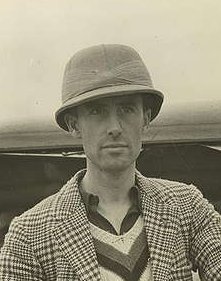 1934
1934 Born 5th June, 1900, London (definitely not Canadian, despite some nasty rumours).
McRobertson Centenary Gold Medal 1934
Royal Aero Club Silver Medal 1934
Holder of 8 Long Distance World Records. 1934
It's difficult to know what to make of Owen Cathcart-Jones, really; he was handsome, adventurous, undoubtedly talented, and clearly an excellent aviator - but, I'm afraid, rather prone to go 'AWOL' - both in his personal and service life!Born in London on 5 June 1900, he joined the Royal Marines in 1919, then, after the usual period of general service he volunteered for flying and joined R.A.F Netheravon on 12 January 1925, in the first batch of Marines officers to be transferred.
He was awarded his 'wings' in August 1925 and was posted to RAF Leuchars, serving with 403 Flight on HMS Hermes, and 404 Flight on HMS Courageous, taking a hand in the troubles in China in 1926-27 and again in Palestine in the following year.
In 1927, he wrote to The Times:
Sir,
On July 17 I had occasion to be flying down the east coast of Greece, and when in the vicinity of Mount Kissavos, near Larisa, I was astonished to see a large golden eagle fly past my aeroplane on a parallel course at a distance of about 80 feet away. The bird did not appear to be at all concerned at the noise of the engine, and in fact turned its head round to look at the aJrcraft on passing. The speed on my indicator showed 70 knots, and the height by my altimeter was 4,000 feet. Judglng by the speed at which I was passed by this bird, I should estimate that it must have been travelling at 90 mp.h.; which I consider to be quite a phenomenal speed for such a large bird at that high altitude.
Yours faithfully,
OWEN CATHCART-JONES,
Lieut. H.M.S. Courageous, at Skiathos, Greece, July 22.
which prompted Mr Seton Gordon, from the Isle of Skye, to reply:
Sir,
The letter from Lieutenant Owen Cathcart-Jones in The Times of July 27 which describes the great speed of a golden eagle in flight is of interest to me, as I have for some time believed the eagle to be one of the fastest birds. On one occasion I satisfied myself that an eagle was travelling at a good 120 miles an hour - probably much more -but then the bird was rushing earthward from a considerable height, and Lieutenant Owen Cathcart-Jones's bird was apparently on a level course. Little is definitely known even to-day as to the maximum speed any bird is capable of. Not so long ago a senior officer of H.M.S. Hood told us that when the Hood was steaming 34 miles an hour into a 15-mile-an-hour wind a formation of guillemots had no difficulty in forging ahead and crossing the vessel's bows. This interesting record shows that even the humble guillemot is capable of an air speed of well over 50 miles an hour, so a speed of 90 m.p.h. is not surprising in a bird of the wing power of a golden eagle.
I am, &c.,
During this time, he met Audrey, the wife of Captain Hugh Fitzherbert Bloxham, late of the Indian Army, then a Colonial Office official in the Prison Department at Hong Kong. Hugh and Audrey had married in St John's Cathedral, Hong Kong, on 6 August 1925.
Clearly Owen and Audrey got along rather well, and in November, 1927, their daughter Imogen was born.
Hugh duly sued Audrey for divorce in May 1928, "on the ground of her adultery, at the Hotel Savoy, Hong Kong, with Lieutenant Owen Cathcart-Jones, of the Royal Marines." The petition was uncontested.
On 12 Aug 1929 in Malta, Audrey had a son, Anthony.
"He established a reputation as a forceful and daring pilot, and one of his escapades became the talk of the Fleet; on 22 Aug 1929 he was on exercises with the Fleet and loaded his plane with a large packet of "service brown" toilet paper intending to drop it on H.M.S. Revenge which should have been last in the line. Unfortunately the C-in-C had inverted the line and he dropped the "bumph" very accurately on the Flagship, H.M.S. Queen Elizabeth. His Flycatcher aircraft was clearly numbered "7" and the Captain of H.M.S. Courageous was called to the Flagship on return to harbour to explain. Cathcart-Jones duly appeared before the Admiral with his reasons in writing [he made up some nonsense about it acting as a 'sighter' for actual bombs] and had to be on his best behaviour for some time."
On 26 November 1929 he made the first ever night deck landing in a fighter aircraft, flying a Fairey Flycatcher from H.M.S Courageous.
"It is a reminder of our one time presence in the Middle East that his record shows his Flight carrying out patrols in Palestine, and the Courageous Flights being shore based at Gaza and Aboukir in 1929 during the 'Civil War'.
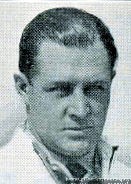
During his Fleet Air Arm service he became very friendly with a wealthy Naval Officer, Glen Kidston, with a similar passion for flying. Kidston was himself leaving the Navy and Cathcart-Jones decided that it was time to do likewise and to transfer his interests entirely to civil flying. He went on to half pay on 17 Febuary 1930 [for 6 months], joined National Flying Services Ltd. and never returned to the Service.
Audrey, by then aged 28, with Imogen (aged 2) and Anthony (aged 1) sailed from Brisbane to Plymouth on the P&O steamship Ballarat, arriving there on 21 Jan 1930.
On 21 April 1930, National Flying Services held their first display at Hanworth Park; Owen provided the finale by bombing a level crossing to bits. However, the meeting was not a success; "for some reason N.F.S. shows do not appeal to the average private owner" and crowds were poor.
In September 1931 he flew a D.H. Puss Moth, with Audrey as passenger, in the Deauville-Cannes Air Rally. After lunch and a gala dinner, they flew on to Cannes, despite a forced landing in the Alps when the fuel pipe and filter were found to be blocked with sand.
By the following May (1932), business was better; "taxi work is now on the increase and the N.F.S. pilots have been kept busy flying to places as widely separated as Plymouth and Berlin". Owen piloted G-ABTZ, a Stinson Junior belonging to Mr. E James, on several flights. On 31 July 1932, Audrey went on a conducted tour organised by NFS, of "eight Moths, one Bluebird and one Alfa Romeo", to Ostend.
Owen and Audrey lived in Tudor Court, Hanworth, London until 1934, but then Owen moved out, leaving her and the two children, who relocated to Wavenden, Bucks. In company with Kidston he broke 8 World records for long distance flights in 1934, including England to South Africa in a Lockheed Vega:

but Glen (centre) was killed in an air crash shortly afterwards.
Owen also came 6th in the 2nd Morning Post Cross-country Air Race on 6 June 1933, and competed in the King's Cup in 1934 (finishing 9th) and 1935 (when he came a creditable 3rd).
Here he is, wandering around waiting to take-off, and taking a pylon in the final of the King's Cup 1934:
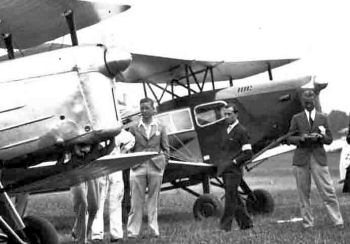
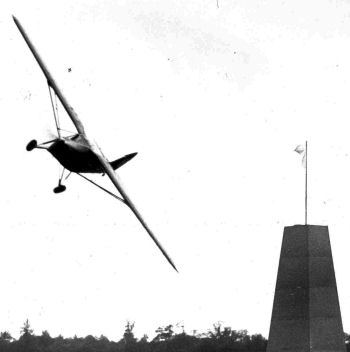
His real moment of glory was to co-pilot with Ken Waller the specially built D.H. Comet in the 1934 McRobertson England to Australia Centenary air race, in which they were awarded third prize in the Speed Handicap. On arrival they immediately turned round and flew back to England and established a record for the round trip.
Originally, he had teamed up with Miss Marsinah Neison in a Lockheed Altair (or Vega), "placed at their disposal by the builders", or possibly a Northrop Delta. However, nothing came of this.
He certainly wasn't first choice as Comet pilot - Bernard Rubin, the owner and intended pilot of the aeroplane, fell ill and originally nominated as substitute Mr Smirnoff 'the well-known Dutch pilot' on October 1st, and then only on October 5th (2 weeks before the race) 'finally and irrevocably' decided it should be Owen who accompanied Ken Waller. Three weeks before the Race, Owen had "never heard of Mr Rubin or Mr Waller", but apparently Marsinah said "Seajay, why don't you try and take Rubin's place?" Owen considered this a "most sporting action" on her part, but this meant that he had very little time to familiarise himself with the notoriously-tricky aeroplane.
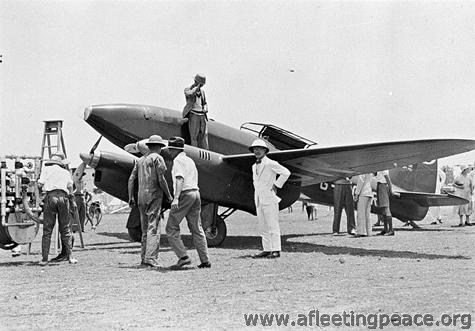
After the return trip from Australia, Owen said "We have averaged 10 hours' flying every day, and covered approximately 2,200 miles a day. We wanted to make this flight back not so much as a speed flight, but as a flight which could be copied for commercial purposes. We have flown only by day, and have had time to sleep, eat, and wash. From the commercial point of view I think there is no reason why there should not be a service between Melbourne and England on similar times to those we have taken, certainly for the carrying of mails.
People in the Colonies were very anxious to have their letters quickly and to have air-mail services covering the distance in so short a time. We had one nasty moment at Allahabad, when we had trouble with two of the cylinders, but the Mollisons came to the rescue and lent us spare parts - a very sporting action. We were greatly disappointed by the delay at Athens owing to bad weather conditions, which prevented us from getting to Lympne yesterday."
Messages of congratulations included this one: "The Duke of Gloucester directs me to congratulate you both on a magnificent double flight - Private Secretary, Duke of Gloucester.
However, even while he was away, the law was after him: "ENGLAND-AUSTRALIA AIR PILOT SUMMONED. Flight Lieutenant Owen Cathcart Jones, of the Naval and Military Club, Piccadilly. who is taking part in the air race to Australia, was summoned at Bow Street Court yesterday, on a charge of using a motor-car with an expired Road Fund licence. He did not appear, and on being informed that Lieutenant Jones was one of the competitors in the England-Australia race, Mr Dummett adjourned the summons sine die."
In 4 April 1935, several visitors arrived by air for the Norfolk and Norwich Annual Dinner, including " Lt. O. Cathcart-Jones and Miss M. Neison in a Puss Moth".
He published his "Aviation Memoirs" in 1935; "... breezy, light and interesting... the book is unusually well illustrated, with photographs which Mr. Cathcart Jones has collected or taken himself, and many of these photographs are extremely graphic and educative." Interestingly, Owen rather neglects to mention anything about his wife and children.
In 1935, Ken Waller got annoyed with him for something he said in this book that Ken felt "reflected on his courage and ability as a pilot", and even went to court over it. Owen replied that "that was the last thing he intended, as Mr. Waller and he had been, and still were, very good friends", which seemed to settle the matter.
Reading the memoirs, I can only assume this was the passage where, having got themselves lost in bad visibility over Arabia during the Race, Owen says that "little did I know that Ken was on the point of asking me to dive the machine into the ground and get it all over rather than face the possibility of running out of petrol, forced landing in the sand, where we certainly would have smashed the machine, and then lie there slowly dying without means of help."
In fact, Owen's is a rather bland account of their two-way trip, and at one point Owen credits Ken with a 'marvellous achievement'; "Ken, under great difficulties, made a superb landing".
Also in 1935, he drove a 4.5 litre Lagonda Rapide in the Monte Carlo Motor Rally, starting from Stavanger in Norway. He was the first competitor to arrive in Monte Carlo, and was thought to have a good chance of winning the first prize, but was eventually placed 34th. His 'second-in-command' was a Miss Marsinah Neison, "one of the very few women to hold a 'B' licence for aircraft".
Owen and Marsinah got up to quite a few things together:
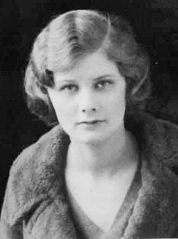
Beatrice Marsinah Neison, b. 3 Dec 1912 in Reigate. She gained her RAeC certificate at National Flying Services, Hanworth on the 11 Jan 1932, and passed the night-flying test in September.
Owen says of her "a young commercial pilot came to me for some advanced flying instructions, and I was very much impressed with the exceptional ability shown by her. Miss Marsinah Neison was the youngest girl pilot to get the coveted 'B' commercial pilot's licence. She qualified for it at the age of nineteen." He reckoned "there was very little I could teach her... I decided that her abilities were far too high to waste, and asked her to join me in any free-lance air charter work in which we could combine".
I'm not suggesting anything untoward, you understand...
In November 1933, she was trying to raise finance for a solo flight to Australia in a Comper Mouse, to beat the record held at the time by CTP Ulm, but never did.
Here she is, ready to go:
She sailed to California in May 1936, to visit her friend 'Russell Pratt', (sounds like an assumed name to me...) and to New York in July 1937. She married Hart Lyman Stebbins of New York 'very quietly' in London in December 1937, (they appear in the 'New York Social Register', whatever that means, for 1941), then Angus MacKinnon in July 1947. She died 29 April 1997 in Hampshire (England).
Anyway, Owen was by now pretty well-known; in May 1935, for example, he, Mrs Mollison (Amy Johnson), Tom Campbell Black, and other aviators took part in a 'Mock Trial', in aid of King Edward's Hospital Fund for London, at the London School of Economics; they were charged with 'Making the world too small'. The following August, he was chief pilot in the 'Jubilee Air Display', also with Tom Campbell Black.

 via Joss Mullinger
via Joss Mullinger"Lieut. Owen Cathcart-Jones and Mr. T. Campbell Black, two of the keenest rival prize-winning pilots in the great England-Australia Air Race last year, are combining in a brilliant partnership to take a leading part in the Jubilee Air Display which will be given at Home Farm, Tehidy, Camborne, Thursday, August 15th. 2.15 till dark. The display which is visiting no fewer than 180 centres throughout Great Britain during the summer months, has been specially planned to provide a striking demonstration of the supremacy of British modern commercial aircraft and the unrivalled skill of British pilots. Public interest in aviation has never been more keen than it is at the present moment."
Don't be fooled into thinking you might have flown in the D.H. Comet, though - Owen flew passengers in a four-seat G.A.L. Monospar, and Tom took them up in an Avro Cadet, a rather pedestrian trainer.
On 31 July 1935, Owen advertised, again in The Times: "Mr Owen Cathcart-Jones requires sponsor to finance building world's fastest commercial aeroplane for nine special long-distance record flights in 1936-7 showing profitable return."
Nothing came of this either...
By December that year, however, Owen was banned from flying in Argentina because of his 'stunts'near a military aerodrome; the following April, his aeroplane was impounded by the Austrian authorities and he had to make his own way back home via Cannes.
Gigi Jakobs tells me that "I came across his name in divorce proceedings for Robin W.G. Stephens and Phyllis Gwendlen (nee Townshend) Fletcher. They started divorce proceedings in late 1936 because, according to Stephens, his wife had committed adultery with Cathcart Jones from Dec 1935 to May 1936."
26 Jan 1937
"Owen Cathcart Jones, the well-known airman, of Grosvenor Street, London, failed to appear at his first meeting of creditors at the London Bankruptcy Court to-day. The assistant official receiver stated fhat the debtor had failed to surrender under the proceedings. A distress was levied at his flat last December, and goods sold in January. A representative of the petitioning creditor said that the debtor took an aeroplane to South America for demonstration purposes. The debtor sold the machine and failed to account for the proceedings, and a judgment for £660 had been obtained against him. Mr Newman said that the debtor in August last was alleged to have landed in Czechoslovakia with two Spanish Nationals, and subsequently disappeared. Whether he is in Spain or not I don't know." said Newman, "but I believe he was in this country December 22 last." The case was left the hands of the Official Receiver as trustee."
The bankrupcy hearing was first delayed, then postponed indefinitely; Owen didn't turn up for any of the meetings.
He somehow became an instructor at the London Air Park Flying Club at Hanworth, an elite government-subsidized club for wealthy patrons. His fellow-instructors included David Llewellyn and Ken Waller.
Five years later, he was, somehow, a Squadron Leader in the Royal Canadian Air Force:
"In March of 1942 he was posted to Western Air Command Headquarters, but nothing is recorded in the WAC HQ diary to confirm this or indicate duties. He was then ‘Posted to ABS’ (Absent), 29 April 1942. It appears that he had gone AWOL (Absent Without Leave), as the diary of Headquarters, Western Air Command, under date of 6 July 1942, read in part, ‘Squadron Leader O.Cathcart-Jones who has been AWL for some time, returned from California to this Headquarters under escort.’ He is then shown as taken on strength of Western Air Command Headquarters, 6 July 1942. Two months later, he was ‘Retired’ from the RCAF”.
Hugh Halliday fills in some background:
"He was living in Mexico City in April 1940 when he applied to the RCAF and was duly commissioned in that force on 16 May 1940 (Pilot Officer, simultaneous promotion to Flight Lieutenant). He was assigned to the Air Member for Operations and Training, AFHQ, and performed well enough that he was promoted to Squadron Leader, 1 June 1941. The timing of this suggests (but I cannot prove it) that he was advanced in rank to give him more credibility with American authorities.
In April 1941 he was sent to California on temporary duty as Special Advisor to Warner Brothers for the film “Captains of the Clouds”. The RCAF paid him a special allowance of $ 10.00 a day for the time he was there. He seems to have considered California a bit of a “hardship posting” because of high costs and a depreciated Canadian dollar. He nevertheless wrote to people at AFHQ (Ottawa) on Warner Brothers stationery, at one point urging that he not be forgotten when operational postings were distributed. As of 20 February 1942, Hal Wallis (Director of the film) was effusive in his praise of Cathcart-Jones both in production and publicity preparation. His services with Warner Brothers apparently ended that day.
On 4 March 1942 he reported back to the RCAF on posting to Western Air Command Headquarters (Victoria, British Columbia). About a month later he was advised that he was to be posted to Station Alliford Bay as Operations Officer. A remote station in the Queen Charlotte Islands, it might nevertheless have been deemed to be in a zone of potential intense operations, given the panic that had engulfed the West Coast following the opening of the Pacific War. Cathcart-Jones would have nothing to do with it. He pleaded personal difficulties – privately he stated that he regarded Alliford Bay as a backwater – and he argued for assignment to Seattle as a Liaison Officer. On 27 April 1942, Group Captain A.D. Hull (WAC Headquarters), having interviewed Cathcart-Jones, wrote, “Squadron Leader Cathcart-Jones has undoubtedly ability. However, he appears to put his personal affairs before the Service. Should be closely supervised on new posting and given an opportunity to prove his initiative and worth.”
The same day (27 April 1942) he was issued a travel warrant to travel from Victoria to Vancouver and thence to Alliford Bay. By then he had cleared out his Victoria apartment and disposed of his books. He took the boat to Vancouver. On 28 April 1942 he crossed the border into the United States, in uniform, stating that he was on RCAF duty to the Fourth Interception Command, and that he was waiting for orders from Ottawa. He then hastened on to Hollywood.
On 29 April 1942 he wrote to Western Air Command Headquarters, submitting a resignation from the RCAF. Since he was already a deserter, the “resignation” was not accepted. In June 1942 he was arrested by American authorities, charged with having made false and misleading statements on entering the United States. He sent a message to WAC, asking that confirmation be sent that he was in California on RCAF Liaison Duty. This, of course, could not be provided (one is struck by the man’s sheer cheek). He was returned under arrest to Canada, reporting back to WAC Headquarters, and his case reviewed in detail on the 9th. Among the issues disputed were his debts ($ 884.09) and whether he should be “retired” or be allowed to resign his commission (his preference). He was retired. It was deemed that a General Court Martial for an AWOL case was “over the top” – he just was not worth it. He had not been paid since the day he went AWOL."
During his time with the RCAF he designed a board game, for which he did all the artwork; he was then involved in The Movies (Technical Director, and a 30-second appearance as 'Chief Flying Instructor' in 'Captain of the Clouds', of which Flight said " it is a first-class production in almost every respect" ).
See the excellent article on Vintage Wings of Canada's website.
He then got mixed up in some tawdry goings-on with Errol Flynn and a Miss Peggy Satterlee..
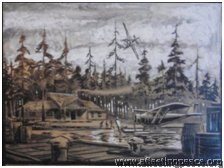
"This painting was done by Squadron Leader Owen Cathcart- Jones when he was an advisor on the movie 'Captains of the Clouds'. He also played a part in the movie. The painting shows the Hudsons Bay Co. trading post where the movie was filmed. When my father-in-law was ten years old, Cathcart-Jones gave him this lovely painting."
with thanks to http://relicsandtales.blogspot.com
He eventually bought a ranch to raise polo ponies, and became President of the Polo Club in Santa Barbara.
His daughter Imogen married John Otis Thayer (from Boston, Massachusetts) in September 1947. She was described as 'the daughter of Mrs A Cathcart-Jones of Wavedon, Bletchley, Buckinghamshire'.
Audrey died in 1962; her son Anthony in 2005.
In 1981, he wrote to 'Flight' "I had a bad accident at polo when I was knocked from my horse and fell on my head, but I am now almost completely recovered and back playing polo again."
Owen died February 1986, in California, aged 85.
Postscript
Imogen's son David actually met him: "Owen lived at 305 San Ysidro Rd., in Montecito. His ranch was about 4 acres at the end of a long driveway that passed through avocado orchards owned by the people who lived down on the road. It's been sub-divided and developed.
Some years ago, I walked up the driveway to discover that his house had been replaced by a large, pink, stucco hacienda and there's a second house, next-door, where his riding ring was. The avocado orchards down by San Ysidro Rd., are gone, too.Owen's sixth wife, and widow sold the place and moved to La Jolla a couple of years after he died. She died three or four years ago.
Imogen was reconnected with her father in the early 50s - he came to visit in 1952 and they wrote and phoned, after that.In the summer of 1965, my parents and their five kids drove out to Montecito, in a camper, and spent about a week at Owen's, just before he married his sixth ? wife, Pat, in August 1965.The following summer, 1966, I went out to visit him for two weeks, and was stranded in Montecito, for the whole summer, because of an airline mechanics strike which grounded the major airlines for 50+ days!It was great fun. My grandfather had to put me on the Continental Trailways bus, in September, to get me back to New York, in time for the first day of school.Owen had a second son, Colin, with his wife, Elizabeth Toomey, who he wooed away from her husband, in Buenos Aires, in 1936. She was married to a Mr. Waterman, who was, according to my grandfather's widow, Pat, the heir to the Waterman ink company. They married and had a son, in England, and came to NY soon after the boy was born. Evidently, in NY, he got involved with Marsinah Niesen, who was there and married to a Mr. Stebbins, and my grandfather walked out on Bette, leaving poor Bette to raise Colin in Queens, NY, with the help of her parents! She got no support from Owen.We have a January 1939 letter, from Colin's mother to my grandmother, Audrey, with her reaction to the news that Owen and my grandmother had not actually been divorced, though we do have a "Deed of Separation" which, I guess, is the precursor to divorce, in England.Bette Toomey Cathcart Jones had written to my grandmother for an affidavit of divorce so that she could proceed with her divorce from Owen. We have my grandmother's draft of the letter that she sent to Bette that prompted this response and my grandmotherher mentions Marsinah as one of the principals in her separation from Owen.Colin CJ died last January [2013]. We had Owen's passport with his and Bette Toomey's photos and Colin's name written in. I looked him up on the Internet and telephoned. We planned to meet but never got the chance. I spoke to him, just a year ago, on his birthday. November 13th." -
Clouston, Arthur Edmond
F/O Arthur Edmond Clouston
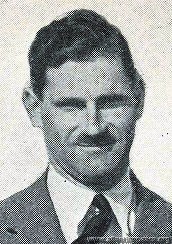 in 1936, aged 28
in 1936, aged 28Famous D.H. Comet pilot, from New Zealand. Civil Test pilot at RAE Farnborough in 1936. Flew Desoutters in other races.
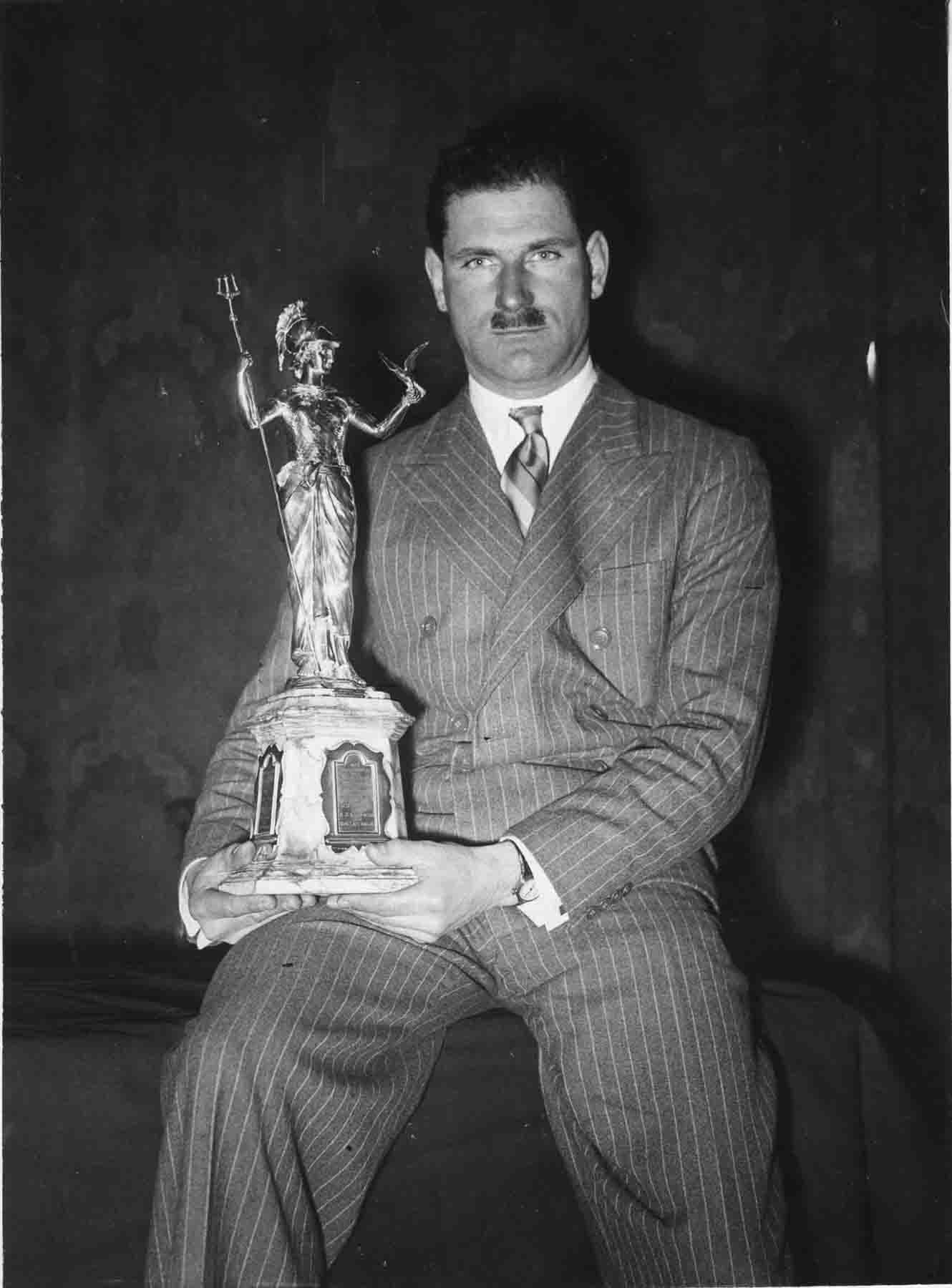 With the Brittania Trophy
With the Brittania Trophy© The Royal Aero Club [0654-0280]
d. 1984
-
Cobham, Alan John
Mr (Sir) Alan John Cobham KBE AFC
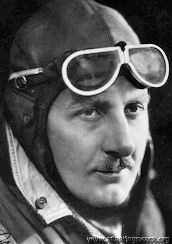 in c.1934, aged c.40
in c.1934, aged c.40
-
Cockerell, Stanley
Capt Stanley Cockerell AFC, Croix de Guerre (Belgium) 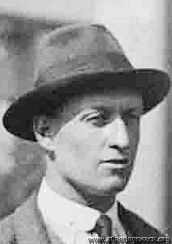
photo: 1930, aged 33
b. 9 Feb 1895, the 'willowy' Vickers chief test pilot - he and his assistant Frank Broome (q.v.) were known as the 'Heavenly Twins'.
RFC in WWI (7 victories).
Married Miss Lorna Lockyer in 1921.
Killed in WWII: on the 29th November 1940, when the Running Horse(s?) Pub in Erith was bombed.
His 6-year-old daughter Kathleen also died and they were buried at the church of Saint Mary, Sunbury on Thames.
Lorna also died during the Blitz. Some children survived and were split up and most were adopted, losing touch with each other.
-
Edwards, Edward Cecil Theodore
F/O (later Flt-Lt, Sqn Ldr) Edward Cecil Theodore Edwards 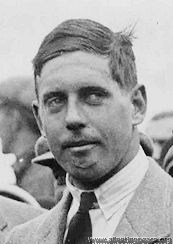 1931, aged 26
1931, aged 26Cecil, brother of Hugh. From Kensington, London. Sometimes known as "Sphinx".
M.A.(Oxon); rowing blue in 1925 and 1926 (when he was the "best man in the crew, as always"); the first member of the Oxford Air Squadron to qualify as a pilot.
Flew, with Winifred Spooner, a Desoutter in an attempt to reach Cape Town in 1930, but they had to ditch in the sea off Italy, and swim about a mile to shore.
Winner of the King's Cup in 1931; here is his "Competitor's Armband" from the race:

Apparently, after the race, "a triumphant Cecil 'Sphinx' Edwards was invited to Sir Robert MacAlpine's house to celebrate the win (Sir Robert had lent Sphinx his Bluebird aeroplane). On leaving the party, Sir Robert grabbed the trophy, said "Well done Edwards" and that is the last that Sphinx or the family would ever see of the trophy. It is now awarded at Henley as The Prince of Wales Challenge Cup after mysteriously being donated to Henley by an antique shop owner."
with many thanks to Gavin Jamieson, who found the armband among his family's archives
Killed in WWII: 31st August 1940, when a Wing Commander (pilot) 53 Sqn RAF; buried in Rotterdam, Holland.
-
Elliott-Lynn, Sophie
Sophie Elliott-Lynn / Lady Mary Heath
Royal Aero Club Certificate No. 7975 (4 Nov 1925)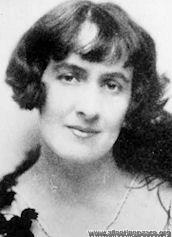 in 1925
in 1925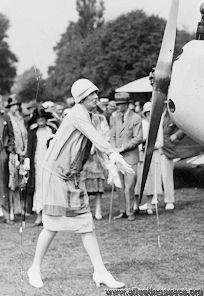
Lady Heath at Roehampton
b. Sophie Catherine Theresa Mary Pierce-Evans on 10th November 1896 in Knockaderry, Co Limerick, Ireland; her crazed father beat her mother to death (with a stick) and was jailed for life, so she was brought up by her aunts.
A well-known, courageous, determined and forceful sportswoman, an athletic 6-foot tall Irishwoman 'never averse to publicity' (which earned her the nickname 'Lady Hell-of-a-Din') who was elected World Champion Lady Aviator by the USA.
At Stag Lane in 1926, Mrs Elliott-Lynn formed a small group owning a pale blue Moth, but was also the "somewhat erratic" pilot of an S.E.5...
...which she crashed a year later at Brooklands.
In the same year, when Lady Bailey and Mrs Geoffrey de Havilland hit the headlines with a world record climb to 17,283 ft, Avro countered with Mrs Elliott-Lynn climbing to 19,200 and making a 1,300-mile trip in a single day, during which she made 79 landings.
Then, her first husband Major Elliott-Lynn having died off, Sophie married Sir James Heath, Baronet, and thereby became Lady Heath.
"Lady Heath stepped from her tiny aeroplane at Le Bourget after her long flight from the Cape in May 1928, as fresh as a daisy. 'It is so safe that a woman can fly across Africa wearing a Parisian frock and keeping her nose powdered all day.' This was the first solo flight from any overseas Dominion to Britain, and she was the first woman to pilot an aeroplane from Cape Town to London.
Unfortunately, Sophie was not very good with Sir James' money; she was rather too easily persuaded to "buy a lot of things" and send him the bill. Having given her £20,000 as a marriage settlement and bought her an aeroplane, he was eventually obliged to take out a note in the newspapers forbidding her to "pledge his credit". The marriage was dissolved in 1932.
Having fled to America, Sophie finally became plain Mrs Williams; he was an airman from Kentucky.
d. 9 May 1939, aged 42, in London when she fell down the stairs of a tramcar. She left £204.
Sophie owned, at various times:
the 1925 prototype DH.60 Moth (G-EBKT), also
a DH.60 Moth G-EBMV,
an RAF SE5A (D7016, G-EBPA),
a 1927 Avro 594 Avian I G-EBQLA,
a 1927 Avro 594 Avian IIR3 G-EBRS,
a 1927 Avro 594 Avian IIIR3 G-EBUG 'for the use of Miss Earhart',
a 1928 DH.60X Moth G-EBZC, and
a 1929 DH.60G Gipsy Moth G-AASY. -
Halse, Stanley Seward
Capt Stanley Seward Halse  1915, when a Corporal, aged 23
1915, when a Corporal, aged 23 1936, aged 44
1936, aged 44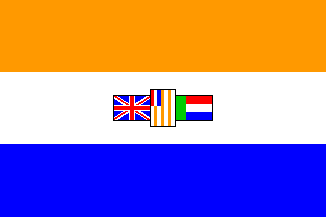 b. 6th December 1892 in Queenstown, South Africa.
b. 6th December 1892 in Queenstown, South Africa.Learnt to fly during WWI, and by 1936 was a flying instructor at the Johannesburg Light Plane Club. Two members (Rex Hull and George Albu) put up the £1,800 required to buy the Mew Gull to enter for the Schlesinger Race. Presumably, that was the last they saw of their money.
Stanley dislocated his elbow in the subsequent crash, and much later found out that three of his vertebrae had telescoped.
-
Henshaw, Alexander Adolphus Dumfries
Mr Alexander Adolphus Dumfries Henshaw 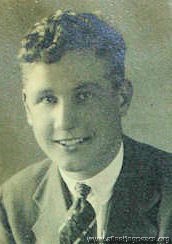 1932, aged 20
1932, aged 20b. 7th November, 1912.
The extraordinary Mr Spitfire. Leant to fly in (of all places) Skegness. "After 25 hours solo bought a Comper Swift and in the 1933 King's Cup Race won the Siddley Trophy with it." In 1936, still the youngest competitor in the race.
d. 24th February, 2007
-
Hilton, Edward Goodwin
Wing-Cdr Edward Goodwin Hilton AFC 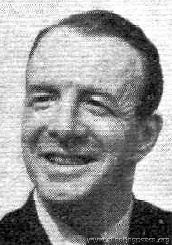 1937, aged 42
1937, aged 42b. 1895 in Surrey
RFC in WWI
AFC in 1920 for 'gallantry and distinguished services' in 70 Sqn, Egypt
A pilot at Martlesham. Made an attempt at the South Africa - England record in 1936 (flying 'Miss Wolseley', an Airspeed Envoy), but was delayed in Athens and abandoned the attempt.
m. 1926 Joyce Elizabeth [Martin]
Entered the 1937 Kings Cup Race, I'm afraid, "largely out of curiosity''. He was thrown out of the aircraft in very bumpy conditions near Scarborough; his passenger (the owner of the aircraft) Wing-Cmdr Percy Sherren, a native of Crapaud, Prince Edward Island, was also killed in the subsequent crash.
-
Hope, Walter Laurence
Capt Walter Laurence 'Wally' Hope 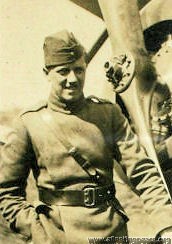 1917, when a 2nd Lieut in the RFC, aged 20
1917, when a 2nd Lieut in the RFC, aged 20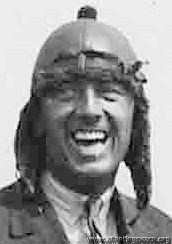 1928, aged 31
1928, aged 31Technical director of Air Freight.
b. 9 Nov 1897 in Walton, Liverpool
Aged 18, and described as a "trick-cyclist", he was summoned in 1915 for committing a breach of the Realms Act by taking a photograph of one of his Majesty's ships at Barrow; he pleaded not guilty, admitted that he was carrying a camera, and was fined £5.
A close friend of Bert Hinkler, he made an extensive search over the Alps at his own expense when Bert went missing on his fatal flight in 1934, but then sued the Daily Mirror when they published their hair-raising account of his exploits, "Captain Hope's Ordeal in the Alps". He said there was "not one word of truth in it."
m. 1920 Marjory [Stone]
Three-time winner of the King's Cup Race (1927, 1928 and 1932)
In the 1926 King's Cup race, "he had to descend at Oxford while racing for home in the last lap with a small “airlock" in his petrol pipe, which effectually put his tiny Moth machine out of the running. He landed in a small field - so small that he found it impossible take off again when his minor trouble had been rectified without pushing his plane through three fields to a broader stretch of country, where he could rise. By this time it was so late that he decided that would abandon the race and go on at his leisure to Hendon.
Interviewed at his home in Hendon yesterday, Mr. Hope said: “The only thing that I am really disappointed about is that I feel sure that if this trifling mishap had not occurred I should most certainly have won. For three laps I was racing neck and neck with Captain Broad, with an aggregate speed equal to his - between 90 and 91 m.p.h." Daily Herald
At the end of the 1928 race, "Thinking all was over he proceeded to loop and stunt before landing, and having landed switched on his well known winning smile. Suddenly there was a terrific hooting, and Sir Francis McClean in his white Rolls-Royce came tearing across to tell Hope he had not crossed the finishing line... Within 30 seconds Hope was in the air again, discovered the finishing line, landed, and again switched on the winning smile fortissimo." C G Grey
Entered for the MacRobertson Race in 1934 (No 24) but didn't take part in the end.
m. 1954 Hilda L [Stone or Hunt]
d. Oct 1979 - Isle of Wight
-
Johnson, Amy
Amy Johnson (Amy Mollison)
Royal Aero Club Certificate 8662 (28 Jun 1929)
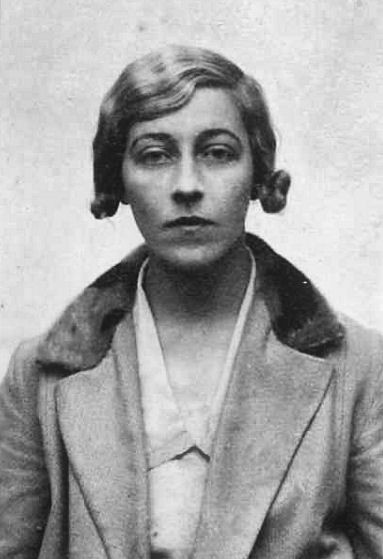 1929
1929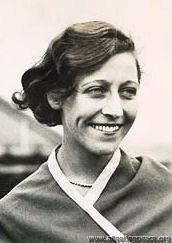
1934
Amy Johnson, Hull's Finest
a.k.a. Amy Mollison
Born 1st July 1903 in Kingston upon Hull; Amy was 'a slight young woman with heavily lidded eyes, dentured teeth, a shy smile and a soft Yorkshire accent' [she later developed a rather fake upper-class BBC one, possibly under her husband Jim's influence].
By 1929, a secretary (albeit one with an economics degree, and an engineer's licence to go with her aviator's certificate) turned solo record-breaking pilot and all-round nation's sweetheart. Married for six years to Jim Mollison (which was a Big Mistake).
On May 26th, 1932, after her solo flight from America, Amelia Earhart was the guest of the Royal Aero Club in London, and amongst the ladies in attendance were Lady Bailey, Amy, and Winifred Spooner (less than a year before her untimely death).
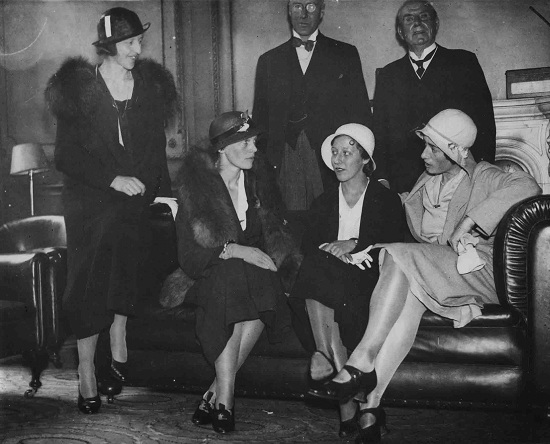
Air Transport Auxiliary in WWII (Died in Service)
Amy's aircraft included:
a 1928 DH.60G Gipsy Moth (G-AAAH) which she named 'Jason', and is now in the Science Museum;
a 1930 DH.80A Puss Moth, G-AAZV, 'Jason II';
a 1930 DH.60G Gipsy Moth, G-ABDV, er, 'Jason III'.
After 1930 she owned:
a 1932 DH.60G III Moth Major, G-ABVW,... ummm, let me guess... yes... 'Jason 4', and
a 1932 DH.80A Puss Moth, G-ACAB, 'The Desert Cloud'.
-
Jones-Williams, Arthur Gordon
Sqn-Ldr Arthur Gordon Jones-Williams MC & Bar Known as 'John Willy'; Welsh Regiment (attached to RFC) in WWI (11 victories).

d. 1929 in the Fairey Long-Range Monoplane which crashed near Tunis while trying to break the world distance record; buried in Newtimber, Sussex.
-
Kidston, George Pearson Glen
Lieut-Comm George Pearson Glen Kidston, RN 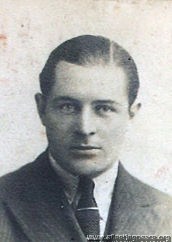 photo: 1928, aged 29
photo: 1928, aged 29Known as Glen. Survived being torpedoed in WWI on the cruiser 'Hague', had several narrow escapes when motor racing, and in November 1929, he was the only survivor when Junkers tri-motor D-903 crashed near Caterham and caught fire. He "escaped through a hole in the side of the aeroplane almost immediately after it struck the ground, and Prince Eugen [zu Schaumburg-Lippe] fought his way out a little later; but by the time would-be rescuers had arrived there was no hope of saving the others." The Prince died the following day.
Glen spent the winter abroad, then in May 1930, his widowed mother having died, put his house up for sale; Nyn Park, Northaw, near Potters Bar, "nearly a square mile with a small mansion". And a lake.
And a 9-hole golf course. Oh, and 25 cottages. A few smallholdings....
In April 1931 he and Owen Cathcart Jones broke the England to Capetown record, but shortly afterwards (5 May) he was killed in the Drakensburg Mountains, Natal; the aircraft he had borrowed, while his Vega was being overhauled, broke up in mid-air during a storm.
Nyn Park was sold, and the estate broken up. The small (23-bedroom) mansion was bought after WWII by the Alexandra Hospital for Children but never used, and burned down in 1963.
-
Llewellyn, David W
F/O David W Llewellyn .jpg) 1932, aged 28
1932, aged 28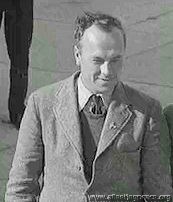 1936, aged 32
1936, aged 32b. 9 Aug 1904 in Wichelsea, E Sussex; son of the President of the Royal Academy.
An instructor at Hanworth.
With Mrs Jill Wyndham, broke the Cape Town-England record in 1935 (6 days 12hr 7min). [I say, who is this Mrs Jill Wyndham, and did Mr Wyndham know about this? *]
Apparently, they had intended also to lower the record for the outward trip. "... they were going strongly, but their chances were ruined by a forced landing in an African rice field. The aircraft was set down by the light of lamps carried by an Arab funeral procession."
He had also flown solo in a "little Aeronca" to Johannesburg, and here he is, in it:
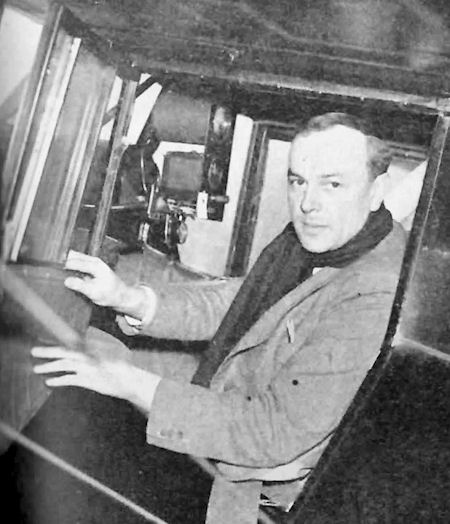
[To be more precise, in the 23 days between the 7th February and 1st March 1936, he flew from Hanworth to Rand Airport, Johannesburg, to deliver the machine to a private buyer. The 2-cylinder engine of an Aeronca produced 40hp.]
Killed 21 September 1938 in an accident in a BA Swallow.
[ *It seems that Doris Jillian Wyndham
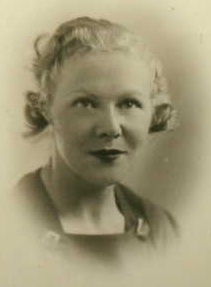
b. 11 May 1911,
was a former pupil of Mr Llewellyn. Or possibly of Tom Campbell Black, if we are to believe Harald Penrose.
Her son tells me that "she died in 1963 at the age of 52. Lt Cdr Wyndham did know about the record attempt!"]
-
McArthur, James Henry Gordon
Mr James Henry Gordon 'Butch' McArthur 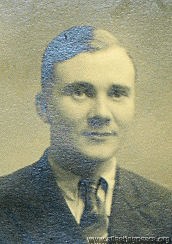
photo: 1935, aged 24
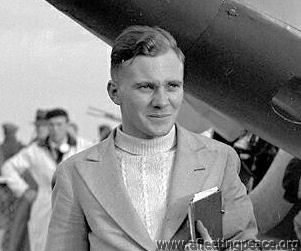
37925 Flight Lieutenant James Henry Gordon ‘Butch’ MacArthur DFC
Born in Tynemouth on 12th February 1913, MacArthur became a civil pilot in the 1930’s, at one time holding the London to Baghdad speed record. He took an RAF Short Service Commission in 1936, being Commissioned as an Acting Pilot Officer on the 6th, and on 18th July was posted to No.9 Flying Training School at Thornaby where he became a full Pilot Officer on 11th October. He then joined the Station Flight at Aldergrove on 14th January 1937 and was promoted Flying Officer on 11th May. On 1st October 1938 he was posted to the Experimental Section, Royal Aircraft Establishment at Farnborough as a test pilot.
MacArthur was posted to 238 Squadron at Middle Wallop as a Flight Commander in June 1940, having become a Flight Lieutenant on 11th May, before joining 609 at Middle Wallop as B Flight Commander on 1st August 1940 under S/Ldr Darley. On 8th August whilst flying Spitfire R6977 he destroyed two Ju.87’s off the Isle of Wight at 12:30hrs, and destroyed a Bf.110 on the 11th, again in R6977, 15 miles south south east of Swanage at 10:15hrs. Flying R6977 again he claimed a Bf.110 probably destroyed on the 12th and Claimed a Bf.109 damaged on the 13th August flying R6977. On 15th August he destroyed two Bf.110's in R6769, one northwest of Southampton and the other 15 miles south south west of this. He claimed another Bf.110 Destroyed on the 25th in X4165 at 17:20hrs in the Warmwell / Poole area and on 7th September he destroyed a Do.17Z in L1008, damaging a Do.215 just over a week later on the 15th in R6979 during an action in which he suffered an oxygen failure at 25,000ft. Attacked by Bf.109’s he lost consciousness and came to just in time to pull out of a high-speed dive at a low altitude. The damage to his ears was to require future hospital treatment, but on the 16th he flew Spitfire R6922 to Hamble for repair. The Air Speed Indicator began to malfunction so he decided to follow another aircraft down onto the runway, much to the chagrin of the pilot of the other aircraft who then went around for another circuit. McArthur followed him for a few more circuits until he finally landed, forgetting to lower his undercarriage in the process and writing off the aircraft. ‘I didn’t like the thing anyway’ he is recorded as saying.
Following medical tests Butch handed over command of B Flight to Flight Lieutenant Dundas, after which he was not allowed to fly above 5,000 feet and in consequence was not able to return to operations, although on 25th September flying X4165 he had destroyed another Bf.110 (reported as a Jaguar) over Bournemouth. MacArthur was awarded the DFC on 22nd October 1940, announced on the 9th in Squadron Routine Orders, and was portrayed by Captain Cuthbert Orde in November.
Subsequently employed on what he called ‘stooge jobs’, he was promoted to the rank of Squadron Leader on 1st September 1941, being promoted to Wing Commander on 1st January 1944.
Released from the RAF in 1947 he joined the Royal Canadian Air Force in Edmonton, Alberta in 1948 and was posted to the Winter Experimental Establishment, testing RAF and Royal Navy aircraft. In 1949 he turned his hand to air racing and was granted leave for the races, acquiring Spitfire MkXIVe TZ138 on 4th August 4th, 1949 in partnership with F/Lt Ken Brown DFC, who had been a Flight Sergeant with 617 Squadron on the Dams raid. Purchasing the Spitfire for $1250, registering it as CF-GMZ on 25th August.
Sponsored by Pat Reid of Imperial Oil, who told Brown 'you have a sure winner on your hands', and granted a Class F racing certificate of serviceability by the Department of Transport, Butch flew from Edmonton via Toronto and raced in the Tinnerman Air Races at Cleveland, Ohio as number 80, finishing in third place in the Thompson Trophy on 4th September 1949 and receiving a substantial prize for his efforts. MacArthur left the airfield the following morning at 06:00hrs with the winnings and without filing a flight plan or informing F/Lt Brown, later selling the aircraft for $1000 to apparently pay for race debts despite the sponsorship.
He was transferred shortly afterwards and served in Canada, the United States and Japan and being awarded the United Nations Korea Medal and the Canadian Forces Decoration.
He was badly injured in an accident involving two cars in 1957, ending up in a hospital in Montreal and leaving the airforce soon afterwards, moving to Mexico. He married and divorced after a few years but remained in Mexico and is reputed to have joined the Mexican Air Force.
Wing Commander ‘Butch’ MacArthur was killed in a flying accident at the Las Vegas Airshow in May 1961 at the age of 48 and was buried with full military honours through the help of the Vancouver Legion. His medals were sold at Sothebys in 1986.
-
Mollison, James Allan
James Allan Mollison MBE 

with Amy and Sir Alan Cobham in 1932 or 33
 Born 19th April 1905 in Glasgow, and educated at Glasgow and Edinburgh Academies.
Born 19th April 1905 in Glasgow, and educated at Glasgow and Edinburgh Academies.RAF commission in 1923, transferred to reserve 1928, then a lifeguard and air-mail pilot in Australia. Made many record flights; his philosophy seems to have been "...one cannot be young for long, and it has always been my practice to live for the moment." He and Amy were married in July 1932, but They Said it wouldn't last, and it didn't; Jim had to fly Black Magic back by himself after the Race; Amy went on KLM.
Jim joined the Air Transport Authority (ATA) early in WWII, and carried on right through until 1946, ferrying more than 1,000 aircraft, comprising nearly every type used by the RAF - he was a 'Class V' pilot (authorised to fly any type of aircraft without previous instruction). He reckoned he had "on a conservative estimate, successfully delivered not less than 15 million pounds' worth of aircraft." - see https://www.ata-ferry-pilots.org/index.php/category-blog-1940/275-mollison-james-allanJim re-married and divorced twice, continued drinking [he once said that, when he was cold, tired and frightened, he recommended "brandy, lots of it"] and ended up as the owner of a hotel in Surbiton, bought for him by his third wife Mary [Kampuis], on the strict understanding that it would never be licensed to sell alcohol.
Died 30th October 1959 in Surbiton, London, aged 54, from alcoholic epilepsy.
 RAeC 1939
RAeC 1939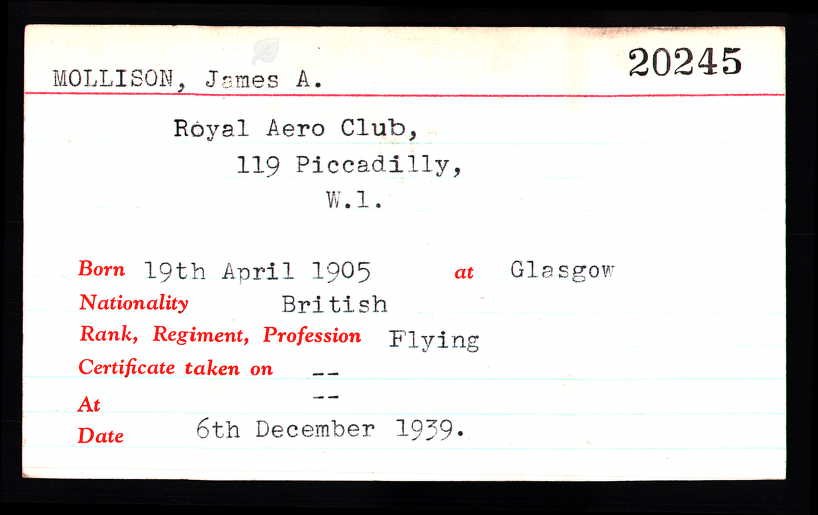 Educated: Glasgow and Edinburgh AcademiesCommissioned RAF 1923, transferred to reserve 1928, subsequently air-mail pilot in AustraliaRecord flights:Australia-England. July/Aug 1931. 8 days 19hrs 28minEngland-Cape (first flight by West coast Route) Mar 1932 - 4 days 17hrs 5minFirst solo Westward North Atlantic flight. August 1932First solo westward south Atlantic flight, and first flight England-South America, February 1933First flight England to USA (with Amy Johnson) July 1933England to India (with Amy Johnson) October 1934. 22 hoursNew York-Newfoundland-London (North Atlantic record crossing coast-to-coast 9 hours 20min) October 1936England-Cape by eastern route, November 1936. 3 days 6hrs.Joined ATA early in war. Released in 1946, after ferrying more than 1,000 aircraft, comprising nearly every type used by RAF - single, twin and multi-engined)Rank: Flight CaptainCategory as pilot: Class V (authorised to fly any type of aircraft without previous instruction)Ferried aircraft all parts of England, Scotland, North Ireland, France, Belgium, Holland.On conservative estimate successfully delivered not less than £15,000,000 of aircraft.For his war-time service in the ATA, Mr Mollison was awarded the M.B.E.
Educated: Glasgow and Edinburgh AcademiesCommissioned RAF 1923, transferred to reserve 1928, subsequently air-mail pilot in AustraliaRecord flights:Australia-England. July/Aug 1931. 8 days 19hrs 28minEngland-Cape (first flight by West coast Route) Mar 1932 - 4 days 17hrs 5minFirst solo Westward North Atlantic flight. August 1932First solo westward south Atlantic flight, and first flight England-South America, February 1933First flight England to USA (with Amy Johnson) July 1933England to India (with Amy Johnson) October 1934. 22 hoursNew York-Newfoundland-London (North Atlantic record crossing coast-to-coast 9 hours 20min) October 1936England-Cape by eastern route, November 1936. 3 days 6hrs.Joined ATA early in war. Released in 1946, after ferrying more than 1,000 aircraft, comprising nearly every type used by RAF - single, twin and multi-engined)Rank: Flight CaptainCategory as pilot: Class V (authorised to fly any type of aircraft without previous instruction)Ferried aircraft all parts of England, Scotland, North Ireland, France, Belgium, Holland.On conservative estimate successfully delivered not less than £15,000,000 of aircraft.For his war-time service in the ATA, Mr Mollison was awarded the M.B.E. -
Rose, Thomas
Flt-Lt Thomas 'Tommy' Rose DFC 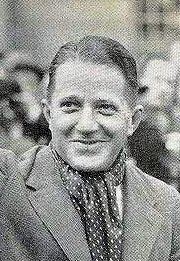 1936
1936b. 27 Jan 1895 - Alton, Hants
One of the best-known racing and pioneering pilots of the 30s.
His father, John, was a farm bailiff at Basing Farm, Froxfield, nr Petersfield, Hants. After working briefly as a bank clerk, Tommy joined the Royal Navy in 1914 and then transferred to the R.F.C. in June 1917.
"He was shot down three times, but escaped each time. He was awarded the DFC for his work with the fighter squadron in which Billy Bishop, VC, served. "
m. 1925 Margaret Elizabeth [Ashford], [divorced 1938]
Retired from the RAF in 1926 with the rank of Flight-Lieutenant.
In December 1931, he made an unsuccessful attempt on the UK-Cape record, and then flew back "by easy stages".
From Oct 1933, Manager and Chief Instructor at Sywell.
"TOMMY ROSE is gone from Sywell, but not forgotten. As sales manager for Messrs. Phillips and Powis, the Reading aircraft manufacturers, he spends quite a lot of time flying round the country. Last week his photograph was 'splashed' in all the national daily papers, greeting Mr. H. L. Brook, the Yorkshireman airman, on his arrival at Croydon after breaking the Australia-England record previously held by Jim Mollison. There was no mistaking Tommy’s famous sports jacket and boyish grin!
Mr. Rose, the way, left a last impression at Sywell. Shortly before leaving, when the new gate was being erected in front of the clubhouse, he carefully placed his foot in the wet cement and printed beside it 'Tom Rose' with a trowel. The cement hardened, and the 'Rose' mark is there for posterity to reverence! Hundreds of feet have since trod the hallowed spot." - Northampton Mercury, 12 April 1935
Competed in the King's Cup six times, winning it in 1935...
![Kings Cup 1938 Tommy Rose [0122-0170]](/images/gallery/air%20races/preview/333s333/Kings%20Cup%201938%20Tommy%20Rose%20%5B0122-0170%5D.jpg)
© The Royal Aero Club [0122-0170]
... and coming second in 1934 and 1936.
[The 1935 King's Cup itself recently sold at auction for £3,900:

Photo kindly supplied by Sarah Chambers, reproduced by kind permission of Sworders Fine Art Auctioneers.]
He became a national hero in March 1936 after his flight to Cape Town and back; "he can now claim to have made the fastest time for the trip both out and home. His new record is 6 days 6 hr. 57 min. (he got to the Cape in 89 hr. 37 min.), which beats F/O David Llewellyn's time—the previous best—by 5 hr. 6 min."
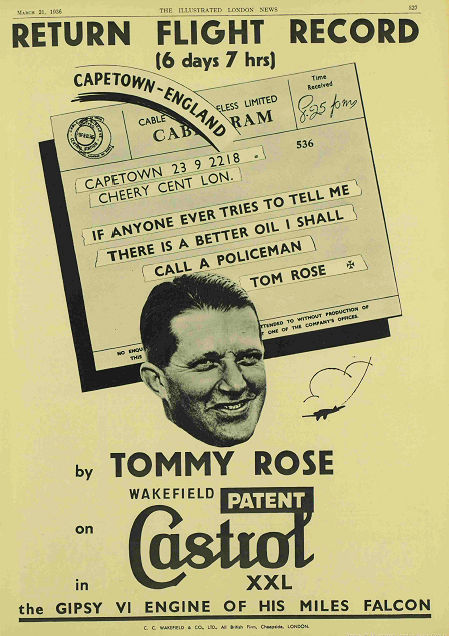
After the flight to the Cape, he had tea with the Prime Minister, General Hcrtzog, and also saw General Smuts. However, he was charmingly modest about his achievements:
"TOMMY ROSE ON LONG FLIGHTS
SAYS RECORD ATTEMPTS ARE 'LARGELY BUNKUM'
This flight business is bunkum! The authority for that picturesquely phrased piece of information is Flight- Lieutenant Tommy Rose, and he should know, for he hit the headlines in all the national newspapers when he smashed all records for the flight from London to the Cape. In a talk to the Round Table at Stewart's Cafe on Monday he summed up the whole business in these few words: 'All long distance flights are largely bunkum. The national newspapers, if there is no other news at the time, whip up an interest in these flights, and if one gets there safely and breaks a record everyone thinks: 'By gad, here's one of the twelve apostles come to life!’ (Laughter.)
'But I assure you there is nothing in it. The only things you have got do to be successful are to get the best machine you can find and then practise sitting still for a long, long time . . . . '
Reflections wise and witty on flying in general and his own flight in particular made Flight-Lieutenant Rose's talk one of the most delightful and amusing to which Tablers have listened to for a long time. His racy manner produced a laugh at almost every sentence, and a more unassuming world record breaker than this genial young man would be difficult to find.
There was one richly humorous story which is worth repeating. 'When I eventually got to the Cape I had to broadcast to the Union,' he said. 'The announcer seemed very nervous and this was what he said: ’Who do you think I have here the studio? None other than Mr Tom Mollison, who flew from London to the Cape in 37 days 18 hours.’ I met General Hertzog few days later and he said: 'if it takes all that time to fly, don't you think you had better come by boat next time?’
Flight-Lieutenant Rose answered a number of questions and urged the need for municipalities laying down landing grounds for aircraft. Members of the Rotary Club and of other Round Tables were present, as guests, to hear the airman’s talk. " - Eastbourne Gazette, 6 May 1936
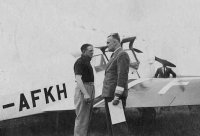
© The Royal Aero Club [0129-0039]
Before the 1936 Schlesinger Race to Johannesburg, he predicted: "It is my opinion that the pilot of the aeroplane which gets there in under forty-eight hours will deserve just about the biggest bunch of bananas ever found.
Having got lost myself many times down this route when flying without wireless, I fully expect to do so again, and the pilot in this race who can honestly say at the end that he was sure of his position all the time will either be very lucky, very clever, or have a queer idea of honesty."
From 1939 to 1946, Chief Test Pilot for Miles Aircraft, living in Sonning, Berks; in July 1943 he was reported to have "improved considerably and to be well on the way to recovery, after he contracted a chill when captaining his works cricket team. "
Won the Manx Air Derby in 1947, still flying a Miles Hawk; three circuits of the island at 181 mph.
d. 20 Jun 1968 - Alderney, Channel Islands.
Page 3 of 4

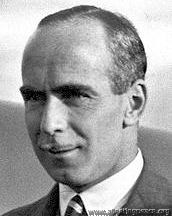 photo: 1934
photo: 1934

